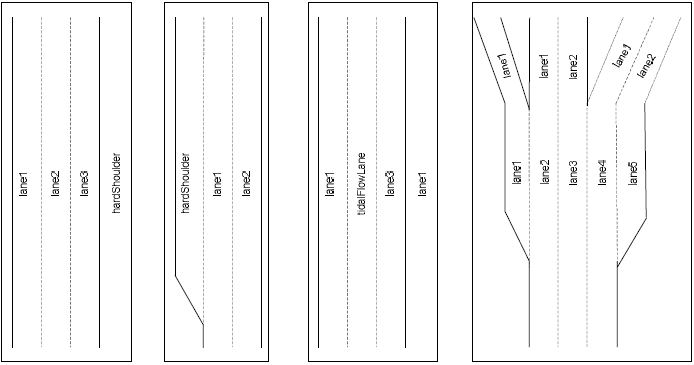Supplementary Location Reference
Road and Carriageway
In addition to the geographical and/or network-related description of the location of an event, more information is available about the exact position of the event. This includes details such as connection roads or parallel lanes, whether the event is on a bridge or in a tunnel. Where possible, this information will be included in the situation description as used by DATEX II. Examples include situations like damagedTunnel and vehicleStuckUnderBridge.
If the DATEX II location reference is not specific enough to indicate what the event applies to, supplementary information is added in an optional element where possible. An example of this is messages about roadworks. The number of different types of roadworks has been kept limited, but it is possible to include one or more descriptions of what is being worked on. Examples include crashBarrier and tollGate. See also the element subjects or subjects in v3.
Finally, there are cases where the previous options do not apply, and additional information is needed to describe the event correctly. In such cases, instead of expanding the event description, the location description is extended with supplementary information. Examples include inTunnel, onBridge, and onLevelCrossing (railway crossing) for location descriptions, and parallelCarriageway or busLane for lane or carriageway descriptions. See also locationDescriptor in v2.3 or infrastructureDescriptor in v3
Supplementary information about roads and carriageways is included in DATEX II in the elementsupplementaryPositionalDescription in v2.3 or supplementaryPositionalDescription in v3.
Lanes
The following guidelines should be used when naming lanes:
- Lanes, except for bus, reversible, and shoulder lanes, are designated sequentially from the road orientation line (WOL) with the values lane1, lane2, lane3 … lane9. From the driver's perspective, lane 1 is the far-left lane.
- Contrary to (1), a rush hour lane that is added on the left side of the carriageway is designated as rushHourLane.
- A bus lane is always designated as busLane.
- A reversible lane is always designated as tidalFlowLane.
- A hard shoulder, where available, is designated as hardShoulder.
- If the entire carriageway is meant to be indicated, the value allLanesCompleteCarriageWay is used.
All other lane designation values permitted within DATEX II are not allowed in the Dutch DATEX II profile.
The reasoning behind this is that using lane numbers (relative to the road orientation line, WOL) provides a traceable lane designation in most cases. Terms like leftLane or lefthandturningLane are not numbered, making them less clear. To maintain consistent lane numbering for a carriageway as much as possible, additional lanes are designated differently. For example, rushHourLane is used instead of designating an additional rush hour lane as lane1, which would cause inconsistencies in lane numbering (e.g., lane1 → lane2 → back to lane1).
The other designations originate from the fact that they are either generally not used for normal traffic (busLane, hardShoulder), or there may be ambiguity about the position of the WOL (tidalFlowLane).
Examples:
Supplementary information about lanes is included in DATEX II in the element supplementaryPositionalDescription in v2.3 or supplementaryPositionalDescription in v3 as well as inmeasurementSpecificCharacteristics in v2.3 or measurementSpecificCharacteristics in v3 .
Go back to the previous page